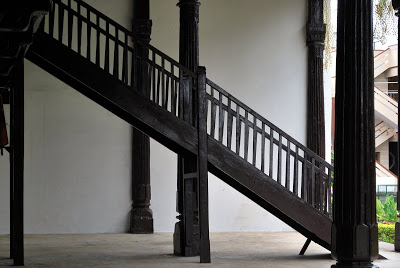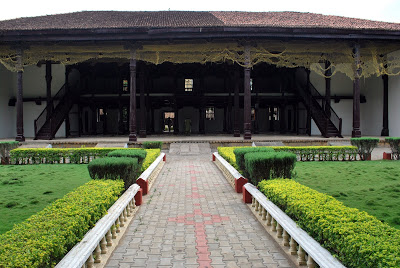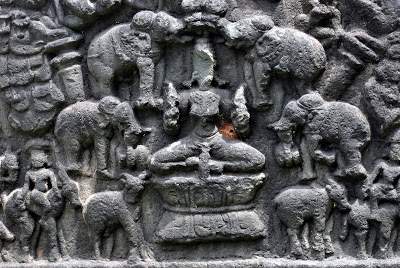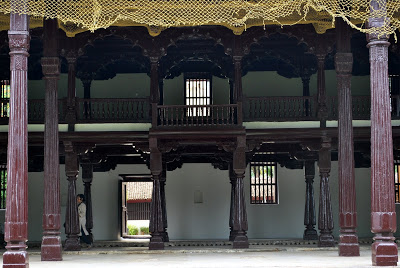Shivappa Nayaka Palace, Shimoga
At first glance it hardly looks like a palace. But on a second glance it does not seem like a saw mill either. To me , it looks like an exquisitely designed home , carved in rosewood, replete with a Mangalore tiled roof with wooden pillars, an open courtyard, two narrow staircases leading to a hall flanked by rooms and a balcony .
It is well past noon and I am in the Shivappa Nayaka palace in Shimoga or Shivamogga, a town located on the banks of the river Tunga in the Malenadu heartland . We happen to be the only tourists in this sprawling palace. The staircase leads us upstairs and we enter the main durbar or the balcony of the palace . Looking out into the vast expanse , we see that the well manicured lawns have turned into a veritable art gallery with ancient sculptures scattered around them. 
We wait patiently for the watchman to finish his lunch and take us on a guided tour. The original palace he says was built by Hiriya Venkatappa Nayak of the Keladi Dynasty in the 16th century. The Vijaynagar empire was declining and the Keladi Nayaks, who were ruling as chieftains under them , had slowly emerged emerging on their own. A local battle fought here between the Nayaks and the Palegars resulted in the former’s victory and hence a fort and a palace were built here. The victory was however shortlived. Soon, Adil Shah of the Bijapur Sultanate destroyed it after a bitter battle and it was later rebuilt by Shivappa Nayak in the Indo sarcenic style. The story however does not end here. When the British took over from the Nayak, they converted the palace into a saw mill to store logs..Finally the monument assumed its current form , after it was restored by the ASI. 
Legends say that the Maratha ruler, Rajaram, the son of Chatrapthi Shivaji was hidden in this palace when he was pursued by the Mughal ruler Aurangazeb. The story dates to the later 16th century when the dynasty was ruled by Rani Chennamma, wife of Somashekara Nayaka . Rajaram, along with his confidants apparently entered her court dressed as a monk , seeking alms. They were passing through her kingdom and they sought refuge . The queen , against the advice of her officials, hid Rajaram in this palace for a few days until he carried on with his journey. While Rajaram escaped, an infuriated Aurangazeb sent his army to defeat the queen, but in the battle that followed, the queen’s forces defeated the Mughals, forcing them to sign a treaty with the Nayaks. 
As the watchman finished the story, the parakeets screeched , announcing their displeasure at our prolonged presence. Looking up , we saw a tree that was filled with bats, who were probably enjoying their afternoon siesta. Fascinated , we watched them for a while and then continued on our quest to see more places and hear more stories. 
A ruthlessly chopped version of this appeared in the Metro Plus today. I have no idea why editors amuse themselves by randomly removing words and paragraphs with no feel for continuity and style. They said it was a space crunch which made them remove 106 words from this story randomly, including the last paragraph


Very interesting. The photographs have helped me to appreciate the magnificence of the palace.
how to go there?
Thanks PNS
Shrinidhi – Its in Shimoga city..
Luks very similar 2 tipu palace in bangalore.
Lakshmi
What a wonderful place, and what a lovely story.
And talking about space crunches, I wonder if there would have been a crunch if the place was owned by not the ASI, but some Shimoga/Karnataka politician.
I am so glad you put the uncut version here….
What a beautifully written piece of a beautiful place! I am not surprised at the way your article was chopped in the name of editing/space crunch by insensitive editors.
very interesting….. we are planning to go via shimoga the next time we go to sringeri…. should plan in this palace too…
A beautiful account of history, well written as usual. Good photographs
Nice post ,was planning to visit this place for a while now
Awesome compositions of this palace, I loved them especially that of the staircase.
I also noticed the stunningly beautiful banner, I guess its from one of your Ladakh trips…Thomas
What an incredible place! Thanks for the tour! Great photos. If you have a few minutes, please stop by my blogs: Levonne’s Pretty Pics and A Camp Host Housewife’s Meanderings. Thanks.
I found your post very interesting because of past reference of Maratha King Shivaji’s second son Rajaram. Yes, he fled from Maharashtra from the clutches of Moghul emperor Aurangjheb and safely hid in the castle at Jinji in South India. But this temporary stay at this palace was nowhere mentioned. Thanks.
Mangesh Nabar
aroma of peace all around !
wow very nice I lik this article very much..good wrieup with remarkable details…
I love the place. The pillars are esquisite. It gives such a homely look!!!
Choolanur Peafowl Sanctuary
Office Style – 12
It was an interesting story to read in metro! Thanks for few more snaps about the palace here.
WOW, fascinating!! think am gonna convince mom to do Shimoga route next time they talk about Sringeri n visit this site… 🙂
Hope Hindu reads this and understands what they did to the story… bah!!
It is a truely good narration of keladi kingdom which makes my heart proud after reading that in am in such a pious place…